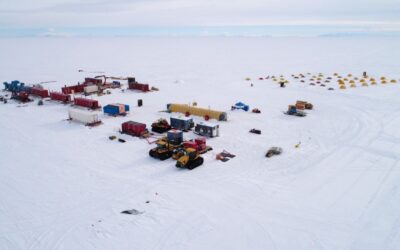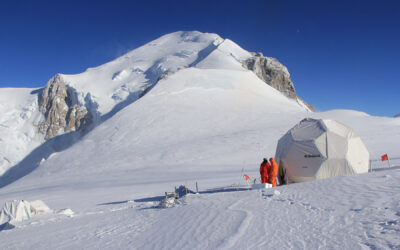DRI’s Erick Robinson, Associate Research Professor of Climate and Archaeology, co-authored a new study that provides insight into North America’s Indigenous communities prior to European contact. Published in the Proceedings of the National Academy of Sciences (PNAS), the research identified the age of archaeological artifacts from across the continent by measuring the decay rate of a radioactive isotope of carbon. The research found that although Indigenous populations varied regionally, the continent saw a population peak around 1150 A.D. before experiencing declines, likely stemming from drought, disease, emigration and warfare. A brief recovery around 1500 A.D. was followed by a sharp decrease upon the arrival of Europeans.
Robinson contributed to the research as a postdoctoral scholar who helped build a comprehensive archaeological radiocarbon database for the lower 48 states.
“Aggregations of radiocarbon ages provide the most powerful indirect ‘proxy’ measurement for past human population growth,” Robinson said. “In the study reported here, we wanted to better understand the population dynamics of Indigenous populations both before and after the arrival of Europeans. The results are startling because they indicate more ebbs and flows in Indigenous populations than previously recognized, ultimately showing peaks in populations before the arrival of Europeans. If Europeans would have arrived a few centuries before, the story of America might be very different than the one we know today. This study ushers in a new era of integrative, multi-scalar, multi-disciplinary research on the deep histories of Indigenous peoples and their environments across the Americas.”
Read the full press release from the University of Wyoming below:
By Chad Baldwin, University of Wyoming
For a long time, researchers have sought to estimate the size of North America’s Indigenous population before European colonization to fully understand its impact.
A new study led by Robert Kelly, professor emeritus of archaeology at the University of Wyoming, reveals significant fluctuations in the Indigenous population of North America before European contact, using radiocarbon data from the past 2,000 years. The full study, “Spatiotemporal distribution of the North American Indigenous population prior to European contact,” was published today (Monday) in the Proceedings of the National Academy of Sciences.
By analyzing radiocarbon records from 18 major watersheds across the continent, the study found that human population peaks varied regionally, occurring as early as 800-770 A.D. in some areas and persisting until after European contact in others. The interior regions of the continent saw declines between 1080 and 1300 A.D., while populations in the Great Lakes, New England, the Mid-Atlantic, the Central Plains, the Northwest and California remained stable until after European arrival.
“Europeans unknowingly arrived at a time when Indigenous populations had already declined,” Kelly says. “Had they come a few hundred years earlier, they would have faced much larger, well-organized societies capable of stronger resistance — potentially altering the course of North American history.”
The study shows that the continent’s Indigenous population peaked around 1150 A.D. before experiencing a decline, with a brief recovery before 1500 A.D., followed by a sharp decrease after European arrival. Precontact declines were most likely due to climate, especially drought, disease in large settlements, emigration and warfare.
In many cases, population declines were linked to migration. Cahokia, directly across the Mississippi River and from present-day St. Louis, and its surrounding areas were abandoned as people moved up the Ohio River and into Tennessee. In northwest Wyoming, the population dropped sharply after 1150 A.D., with some people migrating north and west. In the Mesa Verde region, maize-dependent communities moved south to the upper Rio Grande Valley, while the Ute, a smaller foraging population, resettled the area.
However, migration alone does not fully explain the overall population loss, the researchers say. While European contact had a devastating impact, Indigenous populations did not simply peak in 1500 A.D. and then decline.
Previous studies by other researchers have used radiocarbon data from the Canadian Archaeological Radiocarbon Database (CARD) to identify a pre-contact population decline in North America around 1150 A.D. They linked this decline to disease in large settlements and a lack of radiocarbon dating for post-1500 A.D. sites. However, their study relied on a smaller, less accurate database that was biased toward northern states.
In this study, Kelly and his team used a larger, updated CARD to analyze Indigenous population trends in the continental U.S. over the past 2,000 years. Their findings confirm a widespread population decline, but with regional differences.
Additionally, the study rules out radiocarbon sampling bias as the cause of these trends, providing strong evidence for major demographic shifts before and after European contact.
Warfare can cause major population declines, but a pre-Columbian decline in Indigenous numbers does not mean they were a “dying race,” as colonialist ideology once assumed, the researchers say. Instead, like all human societies, Indigenous populations experienced periods of growth, decline, migration and resettlement.
Also involved in the study were Madeline Mackie, of Michigan State University; Wyoming State Archaeologist Spencer Pelton; and Erick Robinson, of Desert Research Institute in Reno, Nev.
Kelly has worked on the archaeology, ethnology and ethnography of foraging peoples since 1973, working on archaeological research projects in Nevada, California, New Mexico, Kentucky, Georgia, Chile and Wyoming.
To learn more about his research, email him at rlkelly@uwyo.edu.
Contact Us
Institutional Communications
Bureau of Mines Building, Room 137
Laramie, WY 82071
Phone: (307) 766-2929
Email: cbaldwin@uwyo.edu


